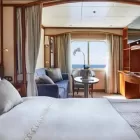Værøy is warmer than any other location above the Arctic circle as it is bathed by the Gulf Stream from the Caribbean. The average temperature generally stays above freezing all year. This may be one reason for the island’s colourful wildflower displays. Several hundred people live on this isolated island, mostly in the town of Sørland. The chief focus of the community is fishing, especially in winter when the Arctic Cod spawn. Værøy, with nearby Røst, is the best seabird breeding area of mainland Europe. Northern Fulmar, Common and Black Guillemots, Razorbills, European Shag, Black-legged Kittiwakes and terns nest here. The seabirds have a range of preferences for nesting sites, from steep cliffs to rocky slopes to flat heathland. Watching soaring White-tailed Sea-eagles is a highlight for visitors, but in days past there was a bounty on them.
At the very southern end of the Lofoten Islands are bird cliffs that hold Norway’s largest colony of Atlantic Puffins, and also good numbers of kittiwakes, Razorbills, Black Guillemots, shags, Northern Fulmars and White-tailed Eagles. Storm Petrels and Leach Petrels can be seen from early July onwards. Characteristic shoreline species are Whimbrel, Red-necked Phalarope, Arctic Skua, Turnstone and Arctic Tern. Slightly further north is Værøy, an island with quite a few specialties. A special dog was bred to hunt puffins –the Norwegian Lundehund- while islanders caught the White-tailed Eagles with their hands! We will go ashore in Værøy and offer hikes and might do a Zodiac cruise along the rugged coast.
Blessed with some of the most spectacular scenery in Norway (and goodness only know that this is land blessed with rolling hills, soaring peaks, valleys, tranquil fjords and white sandy beaches, so the competition is high!), Leknes is what Norway is meant to be. Pretty red houses lay dotted on the green covered hills, and the midnight sun is rises above the horizon from 26th May to 17th July, (while in winter the sun does not rise from 9th December to 4th January). Part of the stunning Lofoten islands, this pretty port offers much in the way of recreation, although understandably most of this is outdoor based. Take a boat ride around the archipelago, try your hand at some deep sea fishing, or simply stroll thought the city centre, perhaps rent a bicycle and discover the hinterland at your own pace.

























